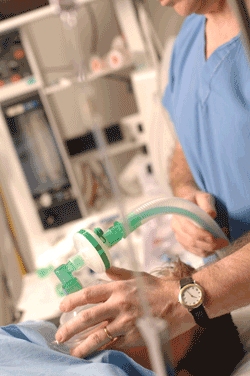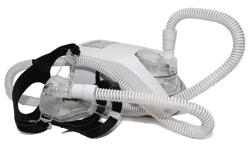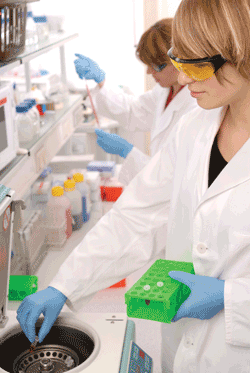Choosing airflow and pressure sensors for medical apps
Special needs and capabilities must be considered when picking sensors for anesthesia, apnea, and hospital diagnostic machines
BY A.J. SMITH
Honeywell Sensing and Control
Golden Valley, MN
http://www.honeywell.com/sensing
Just as there is a true science behind every medical procedure, there is a science behind specifying the air- flow and silicon pressure sensors used in complex medical devices that assist in the diagnosis and treatments of ailments. Three medical applications using airflow and silicon pressure sensors are anesthesia, sleep apnea, and hospital diagnostic machines.
Anesthesia machines
The agents used in anesthesia machines pose unique challenges. The chemicals are often sticky, which can cause build up within the interior of the device. Resilience against these effects must be taken into account when building the machine.

©iStockphoto.com/sturti
Because of the importance of the machine to the patient, choose a sensor that offers extreme sensitivity and accuracy for the life of the machine. Choosing a sensor that meets performance requirements but that is also very stable over time will ensure the sensor can be used over the application’s life. A 10-year sensor lifecycle is possible if the right sensor is chosen.
Engineers should consider the breathing rates of the patients. Patients may range from incapacitated adults with shallow breathing rates, to healthy adults with higher breathing rates and larger lung capacities. The sensing element needs to be extremely sensitive to properly measure the patient’s inhalation and exhalation and the anesthesia gasses being delivered into the airflow. As a result, two and sometimes three, airflow sensors are used to measure the specific pneumatic subsystems. The designer may want to consider dedicating an airflow sensor to any critical subsystem of the machine.
Because the combination of anesthesia agent and high humidity create a harsh environment for sensors, a differential pressure sensor for the exhalation circuit may be considered over an airflow sensor. Differential pressure sensors are more resilient to air media contamination such as humidity, anesthesia agents, and other materials.
Media-isolated sensors are used when a high-pressure delivery source is needed or if a sensor will be in direct contact with concentrated oxygen or an anesthesia agent. Here, a stainless-steel media-isolated pressure sensor may be ideal due to its durability.
If the machine needs to be portable, consider using airflow and pressure sensors with low power consumption. This should reduce the size of the power supply required and help limit the unit’s overall weight. Mounting sensors to a manifold with flow channels helps reduce the design size and weight.
Another consideration is the output. Digital output, such as I2 C and SPI protocols, optimizes resolution of the sensor and integration to the microprocessor. There is still a need for analog output, especially due to regulatory requirements that do not allow software to be involved in some safety circuits. The user may want the raw output of the sensor to trigger alarms or safety conditions. The ability to offer both digital and analog options is important.
Finally, the sensor’s response time is critical to effectively deliver the anesthesia agent to the patient. With today’s technology, anesthesia machine manufacturers expect a 1-millisecond response time.
Sleep apnea machines
Sleep apnea machines are generally focused on patient comfort and are less performance-intensive when it comes to total error band. As they are often used with humidifiers, they need to operate and be stable under higher-humidity situations. They must be durable because they are used in home environments by diverse operators.

Accuracy, stability, portability, and unit size/weight are important requirements. Noise is also important since the device is used during sleep. Using an airflow sensor with a fairly low pressure drop is required because if it is too high, the motor works harder (pressure drop equals resistance in the sensor), increasing noise and reducing the motor’s useful life.
So engineers should choose a sensor capable of sensing differential pressure or airflow at a fairly low rate. The sensor should be able to measure the peak of the patient’s breathing, or the inflection point between inhalation and exhalation. Airflow sensors are sometimes chosen over pressure sensors for more complex sleep apnea machines as the machines need to be more sensitive at low air flow levels.
Once the pressure, airflow, and media requirements are determined, consider accuracy and stability needs, including total error band. Home-used sleep apnea machines have to be durable due to outside factors that affect unit performance.
Amplified digital products are often chosen for financial reasons. It’s less expensive to buy a sensor already amplified than to add the components to condition the signal later. It is also less time consuming to integrate, allowing the designer to implement the sensor faster and bring the end device to market more quickly.
Depending on the type of sleep apnea machine, mechanical requirements (such as size, mounting, and porting) may play a role when designing machines because consumers want smaller, aesthetically-pleasing, portable devices. Custom calibration capabilities may also be considered, particularly with CPAP (continuous positive airway pressure) applications, to optimize product performance so that it best matches the patient’s breathing pattern.
Hospital diagnostic machines
Hospital diagnostic applications include mass spectrometers, chromatographs (for gas, liquid, and HPLC, for example), lab automation systems, and analyzers such as those for blood, hematology, immunoassay, and clinical chemistry.

©iStockphoto.com/AndreasReh
High resolution, accuracy, and stability are critical factors to consider when choosing sensors for hospital diagnostic equipment. The machine needs to be able to detect even the smallest amount of a substance. Therefore, diagnostic machines generally have the highest resolution requirements, usually 16-bit or higher. Sensor accuracy and stability are important to achieving accurate data that is often critical to lab results and life-altering to patients.
Determining the full pressure and airflow ranges and the increment that needs to be detected are the first factors to consider. Hospital diagnostic applications may also require compatibility with media other than clean, dry air. In some diagnostic devices, even the smallest amount of outgasing from plastics or adhesives can pollute the sample and skew the test results. Accuracy, specifically with respect to the linearity and hysteresis errors, is important. Because the sensitivity of the overall system is related to the sensitivity of the sensors used, hysteresis should be minimized. A quarter percent accuracy error is optimal (nonlinearity and hysteresis error), and one-half percent is usually the maximum allowed.
As mentioned, high resolution is crucial, which is why users of diagnostic and analytical machines may choose an unamplified sensor to obtain as much of the core/raw sensor output as possible and create the compensation and amplification algorithms on their own. Some sensor manufacturers offer amplified products with a high resolution A/D converter. Beware that a high resolution A/D converter is not the resolution of the sensor—the resolution of the sensor itself needs to be considered. If the sensor has a lower resolution, the extra bits offered by the A/D will only provide extra unusable data.
Stability is critical because drift can unpredictably affect the sensor reading. If the sensor drifts after the machine is built (calibration is completed before shipment), a skewed result will occur. Sensor construction and implementation should be done to resist thermal and mechanical stresses that can affect stability. A half percent or less for errors related to drift and instability is the maximum accepted in hospital diagnostic applications.
Unlike other medical applications, size is not as critical for diagnostic equipment, as most are larger, nonportable devices that remain stationary in a lab. Resolution, accuracy, and stability should be considered before any physical factors such as output, size, mounting, porting, and power requirements. ■
Advertisement
Learn more about Honeywell Sensing and Productivity Solutions





